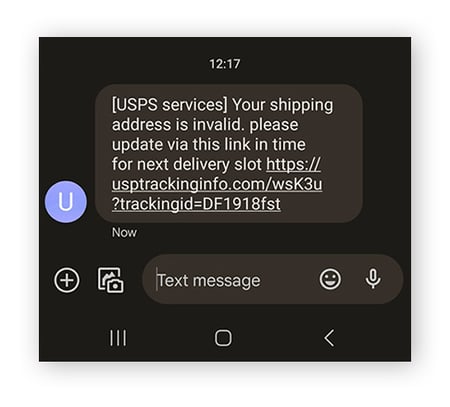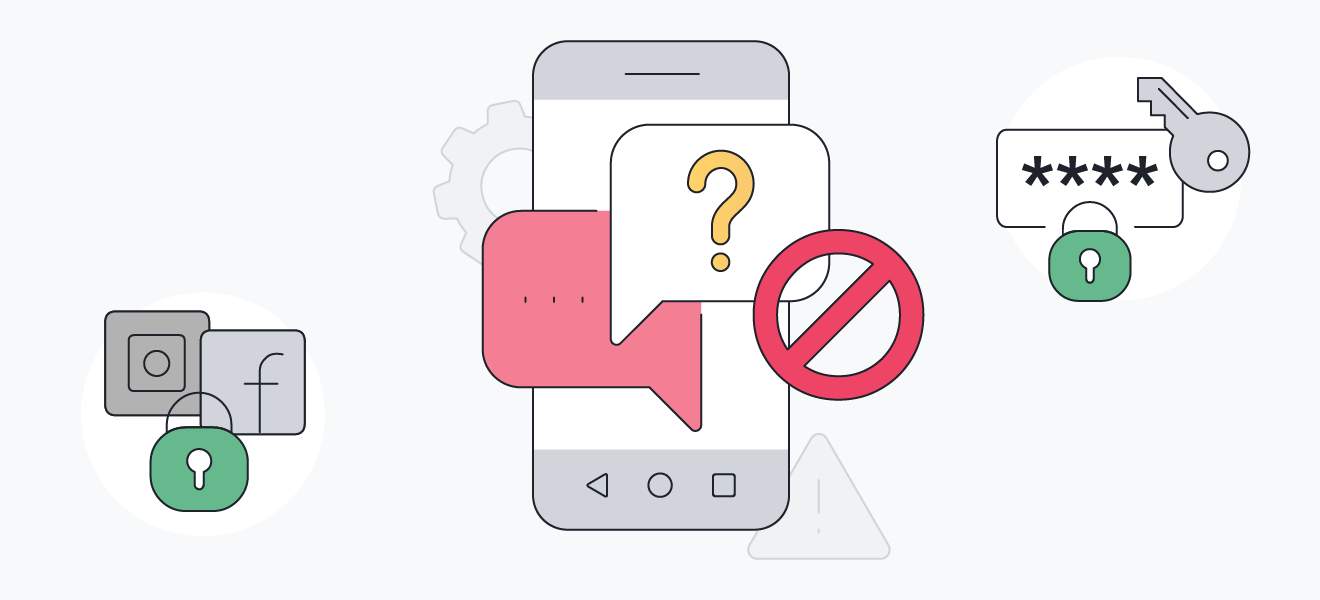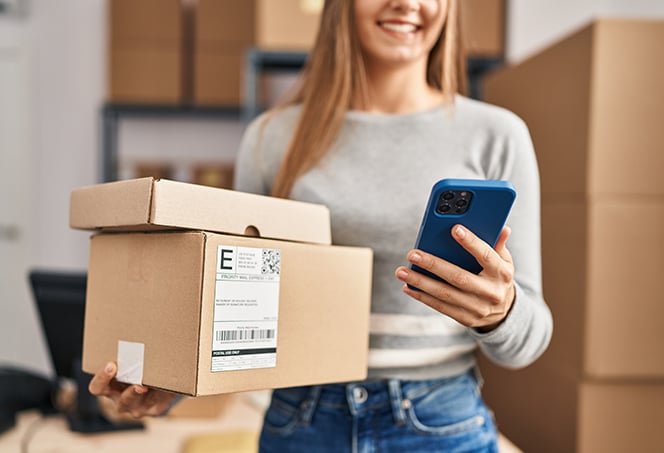USPS text scam real-life examples
Some common USPS text scam examples involve texts claiming your package can’t be delivered on a specific date or requests for extra delivery fees. An example of a scammy USPS text might look like this:
Postal Notice - You have a package that needs to be delivered but was suspended due to unpaid delivery fees.
Check out the real-life USPS scam text I received below, where a fraudster urged me to click a link to update a delivery time. Thankfully, I wasn’t expecting a package from USPS and knew the message was a scam, so I deleted the text immediately and didn’t click the link.

This is a clear example of a USPS scam text, but as scams like these become more sophisticated, understanding how to identify fake text messages is critical.
Understanding USPS tracking scams
Scammers often use phishing messages to trick you into handing over personal information via suspicious links. USPS text scams are no different. Clicking on those malicious links may send you to pharming websites that look suspiciously like real sites, and you can be easily tricked into handing over data, such as your home address, login credentials, or other personal information.
USPS tracking scams didn’t pop up out of nowhere. In 2020, online shopping exploded thanks to COVID-19, which caught the eye of many scammers and thieves. According to Robokiller, scammers sent over 200 billion scam texts in 2022, a 307% increase in scam texts from 2020.
How to recognize USPS text scams
One of the best ways to recognize USPS text scams is to check for grammatical errors and links that are slightly different from official USPS URLs. USPS scheduled delivery text scams also follow many of the same social engineering patterns, such as trying to establish a sense of urgency, found in other messaging scams, like spear phishing.
Here are some signs that the USPS texts you’re receiving are scams:
 Unknown sender
Unknown sender
Authentic USPS tracking phone numbers are five-digit short codes or come directly from USPS. If the number texting you is a personal, 10-digit phone number, there’s a chance it’s a USPS tracking code scam.
 Requests for missing information
Requests for missing information
Real USPS text messages always include a legitimate tracking number, delivery date and time, and a USPS sender (or 5-digit short code). If a text message asks for updated information, it’s likely a USPS scam.
 Strange URLs
Strange URLs
In most USPS text scams, the provided URL will look nearly identical to the real one from the US Postal Service. Go to the real USPS website in your browser to check if there is a legitimate delivery scheduled for you. Never click the link in the text message.
 Requests for extra payments
Requests for extra payments
A dead giveaway that a message is a USPS text scam is a request for extra payment. Often, settlement amounts can range between $1 and $5. Although these amounts seem insignificant, this is part of a larger plan to steal the victim’s financial information.
 Fake USPS tracking numbers
Fake USPS tracking numbers
One of the best ways to double-check if a text message is real or fake is to validate the tracking code. First, enter the tracking number on the USPS tracking website and click Track. If the tracking number from the text doesn't appear on the USPS website, then it’s probably a scam.
 Random delivery-change texts
Random delivery-change texts
If you receive a message about a seemingly random delivery change, don't click any link in it. Instead, to verify a delivery change, send a message to 28777, include your tracking number and enter the USPS keyword When. You’ll receive an official text message verifying the tracking information for your package.
How to prevent USPS scam texts
To help prevent USPS scam texts from being sent to you in the first place, block suspicious numbers when you receive strange texts. Be careful not to give out personal information online, close old accounts you don’t use anymore, and create strong, unique passwords for all your online accounts. Set your social media accounts to private, too, to help prevent scammers from gaining access to your private details.
 To help prevent scam texts, block strange numbers, create strong passwords, and make social media accounts private.
To help prevent scam texts, block strange numbers, create strong passwords, and make social media accounts private.
What to do if you fall victim to a USPS text scam
There are several ways to help rectify a situation if you’ve fallen victim to a USPS text scam. Report any USPS-related smishing (SMS phishing scams) by sending an email to spam@uspis.gov.
This email should contain the following:
After reporting the text scam to USPS, monitor your bank statements for unauthorized payments. Then, run your email address through AVG BreachGuard to check for any data leaks associated with your account. AVG BreachGuard will notify you if it detects that your credentials have been compromised, giving you a chance to change your passwords before you fall victim.
How to protect yourself from USPS scams and other online threats
Although USPS text scams can be convincing, especially if you shop online regularly, there are ways to prevent falling victim. Follow these tips to protect yourself from USPS scams:
-
Shop at reputable stores.
Reputable online shops use reputable shipping companies. If an online shop looks shady, avoid giving them any of your personal information, especially financial.
-
Block spam texts.
If you receive a scammy text, block that number right away and don’t respond. If scammers catch wind that your number is active, they may continue sending even more scam texts.
-
Flag suspicious texts.
Notify the authorities of suspected USPS text scams to help ensure no one else falls victim.
-
Update your device software.
Ensure your device software is up to date. Software updates patch important security vulnerabilities, and regularly checking for updates can help prevent malicious links in scam texts from infecting your device.
Strengthen your online security with AVG
In the fight against USPS text message scams, you’ll also want a comprehensive cybersecurity tool on your side. AVG AntiVirus Free can help prevent you from visiting malicious websites and block suspicious links or dangerous downloads that often accompany scam emails and messages.
With a blend of powerful online protection capable of fighting viruses and malware to keep your device safe, plus phishing detection for your email, AVG AntiVirus FREE helps you secure your digital life. Install it free today.


 To help prevent scam texts, block strange numbers, create strong passwords, and make social media accounts private.
To help prevent scam texts, block strange numbers, create strong passwords, and make social media accounts private.




